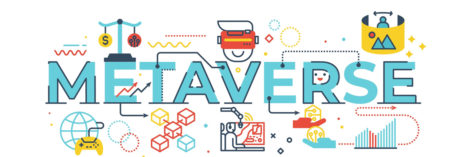Banks are getting into the metaverse. Some of them anyway. But what for? What competitive advantage does a bank gain from its presence in the metaverse? Discover in this article 5 examples of banks already present in the metaverse, an analysis of the current situation, and medium and long-term perspectives.
Examples of banks entering the metaverse
The number of banks currently involved in the metaverse can be counted on the fingers of one hand. For most of them, it’s a matter of buying a piece of land on The Sandbox or Decentraland and opening a performance space there. At the moment, there are not any interactive spaces. It’s more like a place to visit where the bank has a few messages.
JP Morgan
Finding JP Morgan in the metaverse is a little obvious. The investment bank has published a report that estimates the business opportunities it represents at $1,000 billion.
JP Morgan has acquired a commercial space in the virtual mall Metajuku on Decentraland. For those who don’t understand the last sentence, the video below will give you an idea of what a virtual mall is.
The experience proposed by JP Morgan in the metaverse is basic and ultimately relatively poor. Visitors to the mall are greeted by a roaring tiger and a smiling portrait of the CEO. If you are not already discouraged, you can proceed to the upper floor.
HSBC
HSBC has had a plot of land on The Sandbox since March 2022. The video below doesn’t really indicate HSBC’s intentions in the metaverse. Apart from a Minecraft-like visual, there’s not much to conclude from the video other than HSBC “occupying the land.”
Standard Chartered
Standard Chartered announced in May 2022 that it had acquired a parcel of land on Decentraland. At this stage, there is no further information and, of course, no visible realization.
Caixa
The Spanish bank Caixa has a virtual café on Decentraland. It was launched by the subsidiary Imagin in charge of digital innovation. The project has been named “imaginLAND”.
Siam Commercial Bank (SCB)
In Thailand, SCB has a virtual lounge on The Sandbox. The bank’s vision for using the metaverse was discussed at an event called “Open House in the Metaverse.”
The banks in the metaverse only have representation spaces and do not propose interactions with the virtual visitors.
What is the purpose of the metaverse for a bank?
The question is worth asking. Why should a bank enter the metaverse? At this point in the development of the metaverse, there are only 3 explanations:
To occupy the field
Some banks believe in the potential of the metaverse. Their investments are only aimed at “occupying the field” and blocking the arrival of competitors. Remember that the supply of land on The Sandbox or Decentraland (the two most famous metaverses) is limited. As in real life, banks hope that their purchase of potentially strategic locations will give them a competitive advantage in the future. The reasoning behind this is a “first-mover advantage.”
Learning
Banks are at the beginning of their learning curve beyond the strategy of occupying the virtual terrain found in other sectors. Their presence in the metaverse is currently used to “get their feet wet,” i.e., experimenting with new ways of delivering value to their customers.
They may feel that experimentation costs are still low compared to what they could become in the future. The metaverse is still in its infancy today, and in the absence of pressure, it is still easy to test without having to meet specific targets.
Brand image
Finally, the banks’ investments in the metaverse also serve image objectives. The metaverse is intimately linked to NFTs, the crypto universe, and consequently …. to the younger generations. Banks, those dinosaurs that never die out, are keen to appeal to this younger generation. Using a presence in the metaverse to demonstrate their modernity would not be an incongruous marketing strategy. Of course, at the center of this strategy are the “early adopters .”
Besides showing their modernity to customers, the metaverse also allows them to position themselves well with regard to rare profiles (see our article on recruitment in the metaverse). It’s a safe bet that banks will use this tool to attract the good graces of developers, data scientists, and other IT profiles who are always looking for THE company that will help them embellish their CVs.
What prospects for the banking world in the metaverse?
When it comes to the prospects of the metaverse, some people get excited. JP Morgan, for example, has produced a report that puts the opportunities in the hundreds of billions of dollars. This seems like a lot compared to the current opportunities offered by the metaverse for companies. And that, of course, ignores all the challenges, especially the ethical ones, posed by the metaverse.
Perspectives for payment
However, what is certain is that value extraction in the metaverse will necessarily involve a dedicated banking infrastructure. All the opportunities predicted by JP Morgan will only materialize if payments can take place in this new space. And when we talk about payments in the metaverse, we inevitably hear the chorus of blockchain and cryptocurrencies.
By taking their first steps into the metaverse, the few banks we have mentioned intend to be pioneers in decentralized finance (DeFi). The expertise they have already accumulated will, they hope, enable them to find growth relays by taking the lion’s share of the market.
Customer acquisition relays
The metaverse can also be a relay for customer acquisition in the longer term. If banking services really become virtualized in the metaverse, a new technophile clientele could see an interest in it and prefer similar banks.
Posted in Misc..

